- Home
- Peter Tremayne
An Ensuing Evil and Others
An Ensuing Evil and Others Read online
An Ensuing Evil and Others
Peter Tremayne
Peter Tremayne
An Ensuing Evil and Others
PREFACE
My name now appears to be irrevocably identified as the creator of Sister Fidelma, my seventh-century Irish sleuth. From time to time, readers write to me expressing surprise at having discovered that I have written mysteries set in other historical periods and cultures.
It reminds me of when I was a young aspiring writer. I was attending a launch party for a new Nicholas Blake thriller. Nicholas Blake was the pseudonym of the United Kingdom’s poet laureate of the time, Cecil Day Lewis (1904–1972). I had the temerity to ask the great man why he wrote detective stories under a pseudonym. He took my question in good humor. “Because, young man,” he said graciously, “a poet can’t write detective stories.” He was then drawn away into the wine-guzzling throng, leaving me to ponder on his enigmatic response.
It was some time before I understood what he meant. When a writer is known for producing a certain “product,” it is thought that the public won’t allow him to produce anything different. Poor Arthur Conan Doyle; he was driven to killing off his creation, Sherlock Holmes, in his desire to get recognition for his historical novels. It didn’t work. He had to resurrect Sherlock Holmes, and never fulfilled his ambition to be acclaimed as a great historical novelist.
I am not so extreme as to want to kill off Sister Fidelma to make my point. But the fact is that I have written other tales. As well as my own character creations, sleuths created by other writers in the genre have always fascinated me. I suppose my very first crime mystery novel was a genuflection to Ernest William Hornung (1866–1921) and his creation, Raffles, the “gentleman burglar” whose first stories appeared as The Amateur Cracksman in 1899. Only three books of the adventures of Raffles and his fumbling, unwilling accomplice, Bunny Manders, were published, but they achieved a special place in literary criminology. So I decided to continue the Raffles saga with a novel, The Return of Raffles.
The current collection of short stories is put together to demonstrate my fascination with historical settings for crime, ranging from eleventh-century Scotland to the twenty-first century-set somewhere thirty-two thousand feet above the earth!
The title of the first story, “Night’s Black Angels,” might well be taken from the quote from Shakespeare’s Macbeth and does feature that Scottish monarch, but this is a story of the real historical High King of Scotland, who ruled from 1040 to 1057. There is no real Shakespearean connection. This tale takes place in 1033, seven years before MacBeth (a better way of Anglicizing his real name of MacBheatha mac Findlaech) was elected High King, but just one year after he became mormaer, or “provincial ruler,” of the province of Moray. The murder of Malcolm Mac Bodhe, the brother of Mac-Beth’s wife, Gruoch, is recorded in the ancient annals. Who was responsible? In this tale, it is MacBeth who investigates.
Like most writers, however, I am an enthusiastic admirer of William Shakespeare and a frequent attendee at the Globe Theatre in London. I cannot thank the shade of the late Sam Wanamaker (1919–1993), the actor and director who was the driving force in the project to build an authentic replica of Shakespeare’s Globe Theatre in its original location on London’s south bank, called Bank-side. It was while having a coffee at The Globe after a performance that I conceived the idea of a Shakespearean detective. Master Hardy Drew was the Constable of the Bankside Watch. The crimes he has to solve all occur in and around the Globe. “An Ensuing Evil” was written first and relates directly to events arising from the first performance of All Is True, later printed as Henry the Eighth on June 24, 1613. This was followed by “Methought You Saw a Serpent,” inspired by All’s Well that Ends Well, over which there is some disagreement when it was written. I have opted for 1601 and linked it to the execution of Queen Elizabeth Is one-time favorite, the Earl of Essex. Finally, there is “The Game’s Afoot,” inspired by a line from The Life of King Henry the Fifth.
Some readers may note that the name of Master Hardy Drew is my genuflection to a couple of mystery series that I enjoyed in my youth. The Stratemeyer Syndicate in the United States had conjured into being two series featuring teenage detectives-The Hardy Boys in 1927, written by Franklin W. Dixon, and Nancy Drew in 1929, written by Carolyn Keene. Both were in-house pen names. Seventy years later, the books are still being produced and broadcast on radio and television.
From Shakespeare’s London, we move on to the early nineteenth century, during the Napoleonic wars. The action of “The Revenge of the Gunner’s Daughter” takes place during the siege of Copenhagen in September 1807. The Royal Navy bombarded Copenhagen for four days, even though Britain and Denmark were not at war. The attack was to persuade the Danish Regent to surrender his fleet to Britain so that it would not be captured and used by the French. Since I was twelve years old, I have been a devotee of C. S. Forester, devouring all the Hornblower novels. I was intrigued with the idea of how a murder on board a Royal Navy ship o’ war in Napoleonic times might turn out.
We move on to the mid-nineteenth century and the immortal Charles Dickens. “The Passing Shadow” not only features that redoubtable writer as the detective, but also his “sidekick” son-in-law, Charles Collins, a writer, as well, and the brother of Wilkie Collins, who is credited with writing the first modern detective novel: The Moonstone (1868). Although Dickens and his in-laws intrigued me, it was the location that drew me to write the story. It is set in the ancient fifteenth-century tavern, The Grapes, in London’s Narrow Street, standing by the River Thames, near Wapping Steps. It was a favorite location for Dickens, and in addition, his godfather used to be a ship’s chandler nearby. Dickens’s father had stood the young boy on a table in that little tavern and made him sing to the assembly. Dickens describes the inn in Dombey and Son (1848) and used it as a major-setting in Our Mutual Friend (1864). It still stands, and I have often been there, imagining Dickens in the little crowded bar. I once hired the tiny restaurant room upstairs, overlooking the brooding Thames waters, for a birthday celebration for my wife, Dorothy. How could a writer not use such a location to set a Victorian London detective tale?
I doubt whether any writer of mysteries in the world has not been tempted to write a Sherlock Holmes tale, even if they have not actually done so. There are five of my own Sherlock Holmes tales here. The link among all five tales is that I have depicted Sherlock Holmes’s background as an Anglo-Irish one. His creator, Arthur Co-nan Doyle, was the grandson of John Doyle (1797–1868), an impoverished Irish Catholic who left Dublin in his mid-twenties because the Penal Laws discriminating against Catholics prevented him from earning a living as a portrait painter. He became a famous cartoonist in London. One of his sons moved to Scotland, married an Irish girl, Mary Foley, and Arthur Conan Doyle was born in Edinburgh. The Sherlock Holmes tales are replete with Irish names. One thinks of the names of Holmes’s chief enemies, Moriarty and Moran, for a start. Conan Doyle was all too well aware of his Irish ancestry and background. I have opted for Holmes paralleling the educational career of his fellow Irishman, the poet and playwright, Oscar Wilde. Holmes first studies at Trinity College, Dublin, and then obtains a scholarship to Oxford. “The Affray at the Kildare Street Club,” set in Dublin, is, according to my chronology, his first case. The stories are often inspired by throwaway references in Conan Doyle’s own stories. For example, “The Specter of Tullyfane Abbey” derives from the line in “Thor Bridge,” where reference is made to an unrecorded case concerning James Phillimore, “who stepped back into his house to get his umbrella and was never seen again.” And in “The Siren of Sennen Cover,” we learn what Holmes was doing when, according to “The Devils Foot,” he wrote
his monograph on Chaldean Roots in the Ancient Cornish Language. These stories, then, are my “hat doffing” to one of the greatest detective writers of all time.
The period of the British Raj in India always intrigued me as a boy. I was fascinated not so much by Rudyard Kipling’s tales but by those of Talbot Mundy (1879–1940), one of the bestselling adventure thriller writers of the early twentieth century. Mundy had an adventurous life himself; son of a well-known British military family, expelled from the famous Rugby School, he went to the colonies, adventuring in India and Africa, where he misbehaved and served jail sentences before arriving in New York in 1909 under his assumed name of Mundy. In 1911 he began to write for magazines. He became a U.S. citizen in 1917. Several of his books were made into films, notably his King of the Khyber Rifles (1916), filmed once by John Ford with Victor McLaglen as the hero in 1929, and then by Henry King in 1954 with Tyrone Power as the star.
Back in the 1970s, a good friend, the American publisher Donald M. Grant, asked me if I knew anything about Mundys early life. At that time it remained a mystery, because Mundy was not his original name. Don asked me whether, if I could crack the Mundy mystery, I would write a biography for him. I was optimistic. However, from 1976, when Don first suggested the book, it took several years of painstaking research, and it was not until 1984 that Don was able to publish my biography The Last Adventurer: The Life of Talbot Mundy.
“The Eye of Shiva” is just the sort of setting in British India that Mundy worked in as a young man and which he later portrayed so vividly in his many novels and stories. I decided to publish this under an old pseudonym of mine, Peter MacAlan. I wrote eight novels under that name, but Mr. Tremayne outgrew Mr. MacAlan.
Finally, I come to the late twentieth or even early twenty-first century.
When anthology editor Mike Ashley asked me if I could write a “locked room” mystery but one with a difference, I thought I would try to come up with the ultimate locked-room tale. How could a man be murdered in a toilet on an aircraft at thirty-two thousand feet, being shot while the door remained locked from the inside and without anyone noticing anything untoward? As Mike observed when he first published the story, “How much more impossible can you get!”
To conclude this volume, it would be impossible to avoid an encounter with the lady my readers see as their favorite sleuth-Sister Fidelma, the seventh-century Irish religieuse who is a ddlaigh or “advocate” of the ancient Irish law courts. In this new tale, “The Spiteful Shadow,” which has not appeared in either of the Sister Fidelma short story collections (Hemlock at Vespers or Whispers of the Dead), Fidelma is at the ancient abbey of Durrow in another encounter with her old friend and mentor Abbot Laisran. Laisran has a mystery on his hands: Is one of his religious possessed by a malevolent and vengeful spirit?
So these are my mystery short story offerings. Most are slightly different from my usual fare of Sister Fidelma but, hopefully, for the reader, they will all prove equally as enjoyable.
— Peter Tremayne
NIGHT’S BLACK ANGELS
Good things of day begin to droop and drowse;
While night’s black angels to their preys do rouse.
— Macbeth, Act III, Scene ii
“It is plainly murder, my lord,” the elderly steward announced unnecessarily.
What else could a stab wound in the back mean but murder? It would hardly be self-inflicted. The fact that Malcolm, the son of Bodhe, prince of the House of Moray, lay stretched on the floor of his bedchamber with the blood still seeping across his white linen nightshirt did not need a fertile imagination to conjure an explanation of what had befallen the young man.
The corpse lay facedown on the wooden floorboards, clad in nothing else but the shirt, which meant that he had just left his bed to greet his killer. A bloodstained knife had fallen nearby, apparently dropped by the assassin in his haste to be gone.
MacBeth, son of Findlay, the Mdr-mhaor or petty king of Moray, which was one of the seven great provincial kingdoms of Alba, answering to no man except the High King, whose capital was south in Sgain, stared down with a grim face. Indeed, this was his castle, and the dead man was his wife’s brother. He stood with a cloak wrapped around his shoulders to protect him from the night chill. It had been but only a few minutes ago when he had been roused from his sleep by his anxious steward and requested to come quickly to the bedchamber of Malcolm.
It certainly needed no servant or seer or prophet to tell MacBeth that someone had entered this chamber and brutally struck down the young prince and then discarded the weapon.
“Is the castle gate still secured?” he demanded, his voice raised as if in irritation and glancing into the corridor, where a warrior of his personal bodyguard stood impassively.
“Aye, noble lord,” replied his steward, an elderly man named Garban. “As custom decrees, the gate was secured at nightfall and will not be opened before dawn. Your warriors still stand sentinel at the gate and walk the ramparts.”
“So the culprit may yet be within these walls?”
“Unless he has wings to fly or be a mole that can burrow under the walls,” agreed the old servant.
MacBeth nodded in grim satisfaction. “Let it continue to be so, for we many yet snare this evildoer. Now where is Prince Malcolm’s servant? Why is he not here?”
“He was injured, noble lord. He now is being attended to, for in truth, he received a blow to the head, which caused it to bleed. He it was who discovered the body of his master.”
“Then send for him straightaway, Garban. And send for my brehon to oversee these matters, according to the law. There is little time to delay in our pursuit of this assassin.”
While a king or even a chief could be a judge and arbitrator in the law courts, it was, by law, known that a professional and qualified lawyer, a brehon, had to sit with the king to ensure the letter of the law was obeyed and a fair judgment delivered.
The old steward was turning toward the door when there was a cry at the portal, and MacBeth turned to see his newly wed wife, the Lady Gruoch, standing there, a hand to her mouth. Garban, the steward, jerked his head to her in nervous obeisance before he hurried forward to carry out MacBeth’s instructions.
MacBeth turned to his wife. He had thought her still sleeping when he had left the bedchamber to follow Garban. “Madam, I am afraid your brother is dead,” he greeted her quietly, not knowing what else to say but the blunt truth.
Lady Gruoch had seen much violence in her five and twenty years. It had been only one year ago that her first husband, Gillecomgain, the previous petty king of Moray, had been slaughtered in his castle near Inverness with fifty of his warriors. The castle, with its occupants, had been razed to the ground with fire. No one was caught, but whisper had it that the man who ordered the deed was none other than the man whose bed she now shared and who had been acclaimed with the mantle of Mdr-mhaor to replace her dead husband. Yet the Lady Gruoch had long been persuaded to discount such a notion, and she had come to love the young red-haired monarch who offered her and her baby, the young Prince Lulach, his protection.
Gruoch had not been in the castle of Gillecomgain at the time of the attack but away visiting with her newly born son. The people of Moray, bereft of their ruler, turned to MacBeth, whose father Findlay had been king before Gillecomgain. For kingship, like chieftainship, descended by the rule of the ancient laws of the brehons and not by the inheritance of the firstborn male. A king, or chief, had to be of the blood, but they were elected to their office by their derbhjine, four male generations from a common great grandfather. The law of succession had always been thus so that the most worthy and able should succeed.
No one questioned that MacBeth was worthy or that he was able. Indeed, he was also of the blood royal, for he was grandson of the High King, Malcolm, the second of his name to sit on the throne at Sgain. Thus the red-haired young noble had been duly installed as the petty king of the province.
Within the year, MacBeth had convinc
ed the Lady Gruoch that he had not been responsible for her husbands death and had won her love. Scarcely a month had passed since their marriage, at which he had even adopted her son, the baby Lulach, as his own. Yet the evil whispers still remained, and some said that he was ambitious and was only reinforcing his claims to the High Kingship because Gruoch, too, had been the grandchild of a High King, Kenneth III, who had died some thirty years ago. Only in these lands, which comprised the former ancient kingdoms of the Cruithne, was a succession through the female allowed by Brehon Law, but the Pictish custom, as it was called, had not been claimed since Drust Mac Ferat ruled over two hundred years before. So the gossip did not hold water.
More logical tongues pointed out that the Lady Gruoch’s brother, Malcolm Mac Bodhe, as grandson to Kenneth III, had a more popular claim to the throne as next High King. Even if he had not, it was well known that Malcolm II, who had sired only daughters, did not favor his grandson MacBeth, or, indeed, any member of the Moray House. The old king favored his grandson, Duncan Mac Crinan, the son of the Abbot of Dunkeld, and son of his eldest daughter.
The old king and his grandson, Duncan, were of the House of Atholl, and they maintained they had a superior right to the High Kingship at Sgain than the House of Moray, even though his second daughter, the Lady Doada, had married Findlay of Moray and was MacBeth’s mother. The death of Gillecomgain in the previous year was attributed by many of the House of Moray as being a deed carried out at the whispered order of Malcolm II to ensure that Duncan was placed on the throne. Gillecomgain alive had been a threat to Atholls claims. Gillecomgain had been slaughtered. But Malcolm Mac Bodhe, grandson of Kenneth III, had become the next challenger to the continued Atholl dominance at Sgain. Some were already acclaiming him as successor to Malcolm II.

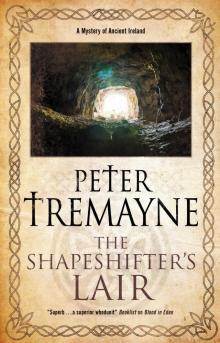 The Shapeshifter's Lair
The Shapeshifter's Lair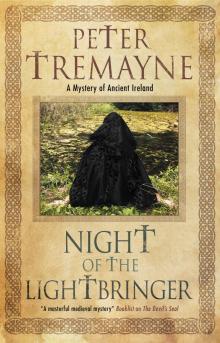 Night of the Lightbringer
Night of the Lightbringer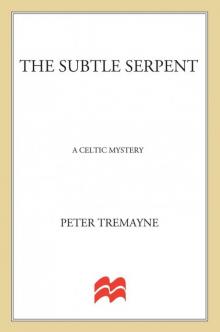 The Subtle Serpent
The Subtle Serpent Smoke in the Wind
Smoke in the Wind Island of Shadows
Island of Shadows The Morgow Rises!
The Morgow Rises! A Prayer for the Damned sf-17
A Prayer for the Damned sf-17 Behold a Pale Horse
Behold a Pale Horse Shroud for the Archbishop
Shroud for the Archbishop The Banshee (sister fidelma)
The Banshee (sister fidelma) The Curse of Loch Ness
The Curse of Loch Ness Whispers of the Dead
Whispers of the Dead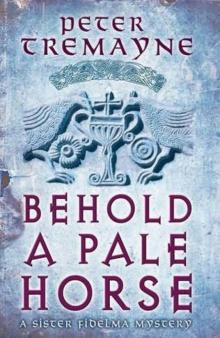 Behold a Pale Horse sf-22
Behold a Pale Horse sf-22 Suffer Little Children
Suffer Little Children The Spider's Web
The Spider's Web Sanctuary (sister fidelma)
Sanctuary (sister fidelma)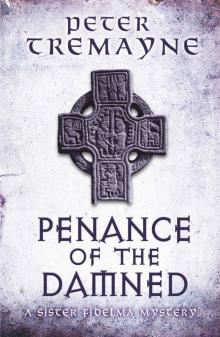 Penance of the Damned (Sister Fidelma)
Penance of the Damned (Sister Fidelma) Absolution by Murder
Absolution by Murder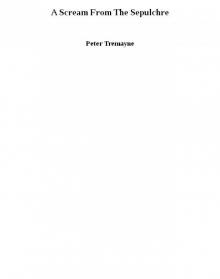 A Scream From The Sepulchre
A Scream From The Sepulchre The Dove of Death sf-20
The Dove of Death sf-20 Absolution by Murder sf-1
Absolution by Murder sf-1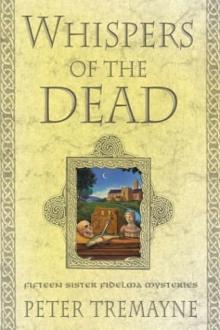 Whispers of the Dead sf-15
Whispers of the Dead sf-15 The Subtle Serpent sf-4
The Subtle Serpent sf-4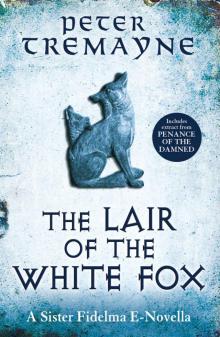 The Lair of the White Fox (e-novella) (Kindle Single)
The Lair of the White Fox (e-novella) (Kindle Single)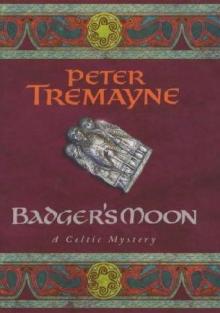 Badger's Moon sf-13
Badger's Moon sf-13 The Monk Who Vanished
The Monk Who Vanished Master of Souls sf-16
Master of Souls sf-16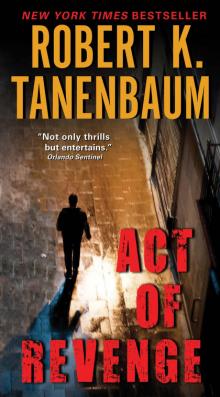 Act of Mercy sf-8
Act of Mercy sf-8 Valley of the Shadow
Valley of the Shadow Act of Mercy
Act of Mercy Dancing With Demons sf-18
Dancing With Demons sf-18 Suffer Little Children sf-3
Suffer Little Children sf-3 The Leper's Bell
The Leper's Bell Master of Souls
Master of Souls Hemlock at Vespers sf-9
Hemlock at Vespers sf-9 The Haunted Abbot sf-12
The Haunted Abbot sf-12 23- The Seventh Trumpet
23- The Seventh Trumpet The Spider's Web sf-5
The Spider's Web sf-5 Valley of the Shadow sf-6
Valley of the Shadow sf-6 Bloodmoon
Bloodmoon Hemlock at Vespers: Fifteen Sister Fidelma Mysteries
Hemlock at Vespers: Fifteen Sister Fidelma Mysteries The Council of the Cursed
The Council of the Cursed The Dove of Death
The Dove of Death The Leper's bell sf-14
The Leper's bell sf-14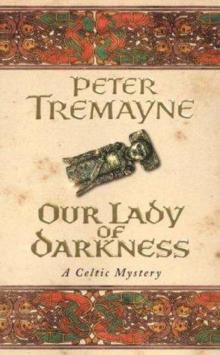 Our Lady of Darkness sf-10
Our Lady of Darkness sf-10 The Council of the Cursed sf-19
The Council of the Cursed sf-19 The Second Death (Sister Fidelma Mysteries)
The Second Death (Sister Fidelma Mysteries) The Fiery Devil
The Fiery Devil Dancing With Demons
Dancing With Demons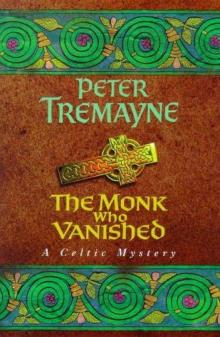 The Monk Who Vanished sf-7
The Monk Who Vanished sf-7 Our Lady of Darkness
Our Lady of Darkness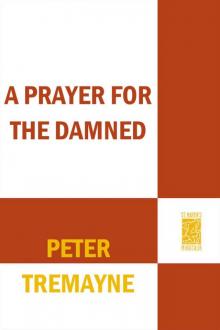 A Prayer for the Damned
A Prayer for the Damned Smoke in the Wind sf-11
Smoke in the Wind sf-11 An Ensuing Evil and Others
An Ensuing Evil and Others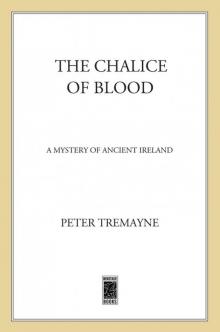 Chalice of Blood
Chalice of Blood